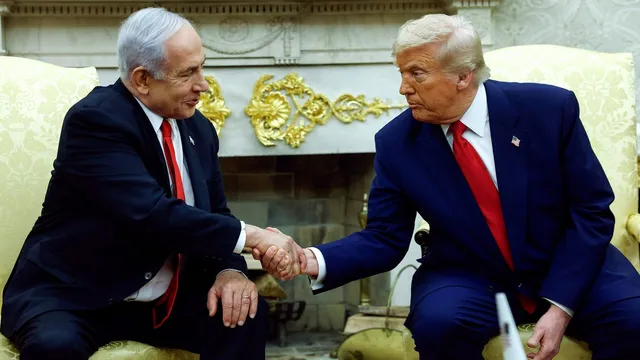
Trump predicts ceasefire between Israel and Hamas within a week
2025-06-30 09:30- Israel's military action has led to significant civilian casualties in Gaza since the war began in October 2023.
- Following ongoing diplomatic efforts, President Trump has expressed optimism about a potential ceasefire agreement with Hamas.
- The complex geopolitical landscape continues to unfold as both humanitarian efforts and peace negotiations face numerous challenges.
Express your sentiment!
Insights
The conflict in Gaza remains intense as Israeli strikes have resulted in a significant number of casualties, reportedly killing over 56,000 Palestinians following Hamas's attack on Israel on October 7, 2023. This war began when Hamas militants targeted southern Israel, killing around 1,200 people and taking numerous hostages. In response, Israel initiated an invasion and aerial bombardment of the Gaza Strip. Amid this devastation, President Donald Trump announced his belief that a ceasefire between Israel and the Iran-backed Hamas could potentially be reached within a week. His comments came after discussions with involved parties, suggesting that negotiations might be resuming. Despite the ongoing violence, the U.S. administration continues to push for an agreement, as evidenced by Trump's recent commitment of $30 million in aid to the Gaza Humanitarian Foundation (GHF). The GHF aims to distribute millions of meals to Palestinians, becoming a controversial alternative to aid supplied by United Nations agencies, which have encountered corruption issues. Trump highlighted the U.S. efforts, emphasizing the necessity of providing aid, especially as many Palestinians suffer from food scarcity. Reports from various humanitarian organizations claim that there have been violent incidents during aid distribution, raising concerns over the safety of these sites. The situation is further complicated by Hamas's stipulation that it is willing to release hostages in exchange for a ceasefire, while Israel demands the disarmament of Hamas. This ongoing deadlock reflects the entrenched positions of both parties. Trump's recent prediction of a potential ceasefire comes at a pivotal time when U.S. negotiations regarding other regional conflicts, such as with Iran, have been making progress. Israeli Prime Minister Benjamin Netanyahu has also expressed hope for peace opportunities resulting from Israel's military successes against Iran. However, calls for a temporary truce to facilitate additional hostage releases remain heavily contested. As discussions advance, the plight of ordinary Palestinians continues to worsen under the spell of war, with many facing dire humanitarian conditions. The situation in Gaza illustrates the urgency for a sustainable resolution to provide safety and relief for millions affected by this ongoing conflict. The role of the international community, including the U.S. involvement, is critical in shaping these negotiations moving forward.
Contexts
The current situation in Gaza represents a dire humanitarian crisis that has escalated due to ongoing conflict, limited access to basic essentials, and the significant strain on healthcare and infrastructure. The blockade imposed on Gaza has restricted the movement of goods and people, exacerbating poverty and limiting opportunities for the population. As a result, nearly two-thirds of the population is in urgent need of humanitarian assistance. The rising number of internally displaced persons adds to the already critical situation, with many families facing inadequate shelter and a lack of basic utilities such as clean water and electricity. Healthcare facilities in Gaza are overwhelmed, operating under severe constraints exacerbated by shortages of medical supplies and personnel. The fallout from previous military escalations, combined with the COVID-19 pandemic, has left the healthcare system on the brink of collapse. Reports indicate that essential services such as maternal and child health care are significantly impacted, directly affecting the well-being of the most vulnerable groups. The psychological toll on the population is also substantial, with numerous individuals suffering from trauma and mental health issues arising from conflict and instability. Food insecurity remains a pressing issue, with a large portion of the population relying on food assistance for their daily sustenance. Agricultural activities have been severely hampered due to restrictions on movement, limited access to resources, and the destruction of farmland during conflicts. Consequently, the availability of nutritious food is limited, which has led to malnutrition rates climbing, particularly among children, who are at risk of long-term developmental challenges. The international community has repeatedly called for measures to ensure the provision of humanitarian aid and for improvements in the living conditions of the people in Gaza. Efforts to alleviate the humanitarian crisis have met various challenges, including political complexities and limited funding for aid programs. Organizations on the ground continue to advocate for greater access to aid and the resumption of dialogues toward a sustainable solution to the ongoing conflict. It is crucial that the international community prioritizes humanitarian assistance and works collaboratively towards a resolution that not only addresses immediate needs but also seeks to build a foundation for long-term peace and stability in the region.